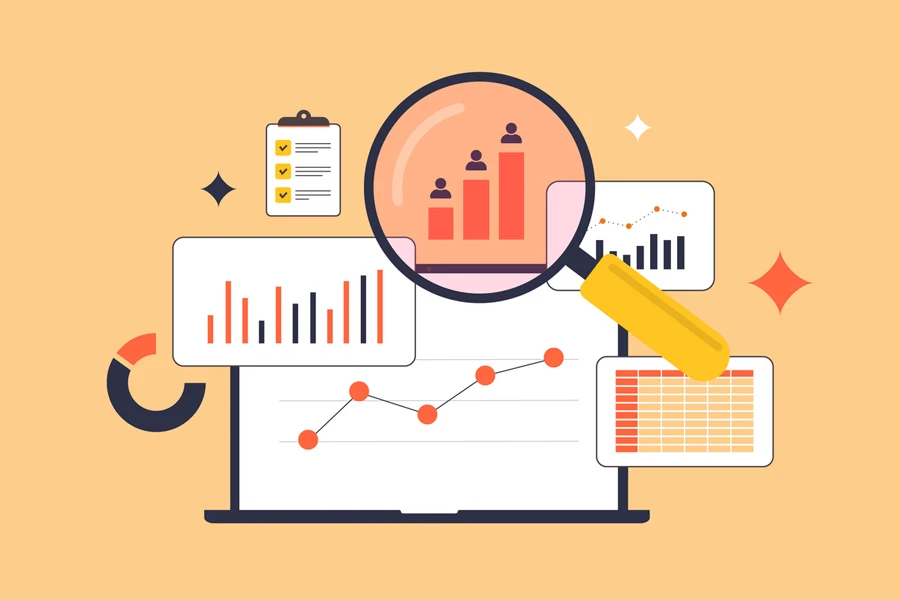Competitive intelligence – the close monitoring of competitors’ messaging, products, and tactics – is a key part of any marketing strategy, helping businesses stay ahead and make smarter decisions for improved long-term success.
Despite its importance, reading reports, glancing at CRM data, and scanning competitors’ social media and websites can feel more like a dreary task than a worthwhile exercise. Businesses might even only have one battle card for their sales team and update it once a year. But real, impactful competitive intelligence should go well beyond that.
Here, we’ll explore what exactly competitive intelligence is and how companies can best utilize freely available information to gain the upper hand on their competitors.
Table of Contents
What is competitive intelligence, and why is it important?
Types of competitive intelligence
5 steps for improved competitive intelligence research
Top sources for businesses to gather competitive intelligence
Rounding up
What is competitive intelligence, and why is it important?

Competitive intelligence (CI) involves gathering strategic data on the competition and the market to make more informed business decisions. It might include everything from monitoring their social media activity, pricing, brand positioning, product offerings, or job postings. The goal is to take this information and form a clear picture of a competitor’s strategy.
A solid competitive intelligence strategy can help businesses confidently plan their next move. By understanding what competitors are aiming to achieve, brands can stay ahead of the game and shape their approach in ways intended to tip the odds for success in their favor.
Why competitive intelligence is important
Competitive intelligence helps businesses make data-driven decisions instead of relying on guesswork. The result? Quicker implementation and get better results. For example:
- Sales teams can easily adjust their pitches to counter competitor claims or weaknesses
- The marketing team can fine-tune their messages to stand out from the competition
- Product teams can plan new features that competitors may have missed
CI also allows companies to spot trends faster, meet market demands, and tackle challenges before their competitors. It’s a great way to gain a competitive advantage consistently over time.
Types of competitive intelligence

1. Strategic competitive intelligence
Strategic competitive intelligence helps shape a business’s long-term goals and direction. It handles more than just day-to-day decisions, guiding brands toward more big-picture planning.
For instance, companies can use strategic competitive intelligence to determine when to explore mergers or acquisitions. It can also help plan when to reach for more market share or expand into new niches. Strategic competitive intelligence can provide all the insights businesses need to make forward-thinking decisions that resonate with their broader objectives.
2. Tactical competitive intelligence
Tactical competitive intelligence tackles quicker, short-term informed decisions. It involves using real-time data to react to immediate challenges and opportunities. For example, it can help a company handle sudden supply chain issues.
Tactical CI can also help adjust a marketing campaign on the fly, helping a business to stay flexible and responsive and ensuring it can quickly adapt to market changes.
5 steps for improved competitive intelligence research
Step 1: Identify the main competitors

Businesses can gain competitive intelligence by analyzing their competitors, but first, they must choose which rivals to focus on.
It’s best to look at two or three brands that pose the biggest threat, and while they don’t have to be the largest players, they should be the ones most likely to share the same target customers. Including more than one competitor is a good idea because it creates a fuller, more reliable picture and draws more data for easier analysis.
Note: Sem Rush is a great free tool to help discern your closest competitors in the target market. There are also myriad paid alternatives on the market.
Step 2: Gather and organize the data
The goal of competitive intelligence is to gather relevant, reliable data. Hence, more isn’t necessarily best; instead, businesses must focus on collecting quality information that gives them real insights into their market, competitors, and audience.
For example, take a business that only has an online-only store. Since it does not require a physical store, it’s unlikely to need to gather data on its competitors’ brick-and-mortar locations. Instead, it should focus more on breaking down the competition’s online strategies and presence.
Most importantly, businesses must be careful where they get their data. If they get inaccurate, outdated, or incomplete information, it can lead them to the wrong conclusions and cause more harm than good.
Once suitable data has been attained, remember to organize it in a way that is easy to analyze. Some data organization tips include:
- Use clear file tags and names
- Use specialized tools or spreadsheets to allow for quick changes
- Monitor where and how businesses collect the data
- Organize the data by type (e.g., folders for each competitor/product)
- Share data with relevant teams for even more verification
Step 3: Start analyzing the data

This part is where businesses transform all that raw data into valuable insights. Here’s an example of product pricing data of three competitors over five months:
| Competitor | Month 1 | Month 2 | Month 3 | Month 4 | Month 5 |
| Comp. 1 | US $499 | US $449 | US $399 | US $399 | US $449 |
| Comp. 2 | US $649 | US $649 | US $599 | US $599 | US $549 |
| Comp. 3 | US $399 | US $349 | US $299 | US $299 | US $299 |
Here’s what businesses can gather from this raw data:
- The highest price offered for a product was US $649
- The average price surged in the first month
- Competitor 2 had the most expensive prices every month
Step 4: Tailor the business strategy
Now, it’s time for to turn insights into a clear action plan. Businesses should use what they’ve learned from their competitors, audience, and market research to fully understand the challenges. Then, they can align those findings with specific business goals.
For instance, if the research shows that consumers want more affordable options due to economic changes, businesses can adjust their pricing strategy to offer lower prices than competitors. However, it goes without saying that they should do this while keeping revenue targets in mind.
Step 5: Monitor results and adapt continuously

Don’t create one competitive intelligence report and use it forever. Businesses hoping to grow and stay successful must consistently track the following:
- The business’s performance
- Market trends
- What the competitors are up to
- Shifts in consumer behavior
Then, they can adjust their strategy based on what they find. Ideally, businesses should review these aspects once a month, depending on their capacity. They can also use tools that send automatic reports and alerts to help them stay updated without extra effort.
Top sources for businesses to gather competitive intelligence

Smaller businesses might not have the budget to hire competitive intelligence professionals, but they can still gather valuable insights in-house. They can collect competitive information through simple methods like market research tools, online searches, and even customer or employee feedback. Here are some quality sources to help businesses find their competitive edge:
- Company websites for audience insights, pricing, and strategies
- Social media for clues about upcoming services
- Job postings that hint at new projects
- User groups on LinkedIn, Reddit, and Glassdoor
- Press releases for product or expansion news
- Sales processes to see how their teams work
- Online aggregators like Dun & Bradstreet
- SEO tools for marketing insights
Rounding up
Staying ethical and following the rules is essential when conducting competitive research. Avoid potentially misleading tactics, as these can lead to serious legal consequences. By sticking to industry best practices, you can avoid any unwanted consequences.
Additionally, businesses can save time and money in the long run if they are able to hire a competitive intelligence professional. In the meantime, follow the steps and tips above to create a compelling competitive intelligence report.



